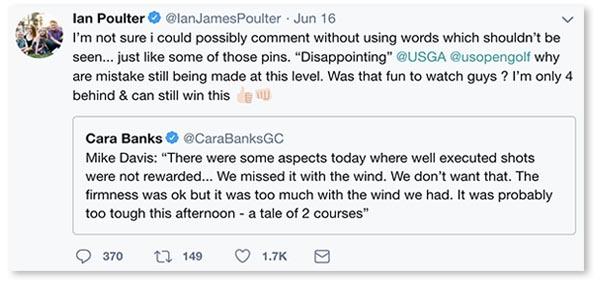Reality TV has nothing on the golf business.
 When Brooks Koepka walked off the 18th green Sunday, he brought the unnecessary drama at the 118th U.S. Open to a merciful end. So what if Tony Finau and Daniel Berger were still on the course? The book closed on this year's Open the moment Finau's tee shot on No. 18 went astray.
When Brooks Koepka walked off the 18th green Sunday, he brought the unnecessary drama at the 118th U.S. Open to a merciful end. So what if Tony Finau and Daniel Berger were still on the course? The book closed on this year's Open the moment Finau's tee shot on No. 18 went astray.
For the record, I have no problem with the way Shinnecock Hills played. You play the course that lays out before you. That's the nature of golf, whether you're putting for $5 or $1 million.
The issue here is conflicting messaging at every turn surrounding this year's Open and the failure of the USGA to consistently recognize the greatest asset at its disposal during its biggest event of the year - the golf course superintendent.
From off-color greens, to tricky pin placements, to a boorish and tiresome New York gallery to one of the game's biggest names making a mockery of the rules for his own benefit - and the chatter that accompanied each - the end to this sideshow, that at times was more like something on TruTV than Fox Sports, couldn't come soon enough.
We have come to accept certain things about professional tour golf, especially USGA championships, namely lightning-fast putting conditions in which greens sometimes are pushed to the brink of failure and really long grass off the fairways.
Was it necessary to push Shinnecock's putting surfaces to the point where calling them "greens" was a misrepresentation of the facts? Regardless of your feelings on how Shinnecock's putting surfaces played, they looked awful and that fed into what the media wanted - a controversial storyline that dominated the weekend.
It's hard not to empathize with Shinnecock's members, as well as superintendent Jon Jennings and his crew, all of whom have invested a tremendous amount of blood, sweat, tears, time and money into preparing for this event, only to have the USGA foul it up. They turned over a perfect golf course to the USGA, which turned around and gave the world what looked on HDTV to be the second coming of the 2004 U.S. Open, when then-superintendent Mark Michaud's team was dragging hoses between Sunday pairings to keep the greens alive.
Shame on the USGA for again wresting control away from a great superintendent, and pretending to know more than the man who eats, sleeps and lives conditions at Shinnecock 365 days a year and proving that you don't by creating a needless subplot about course conditions during the biggest event on your calendar.
What a joke.
The Golf Channel's Brad Klein was on site all week, and said repeatedly that course conditions held up despite how they looked on television. Klein has built a golf course, consulted on others and knows more about golf course architecture than most, so his word is good enough for us.
Not everyone who spent the week at Shinnecock felt the same way.
After Sunday's final round, the Golf Channel's Rich Lerner called Saturday's proceedings "an embarrassment," and Zach Johnson went on record Saturday saying the USGA had "lost" the golf course, Ian Poulter tweeted that perhaps Bozo the Clown was responsible for set-up and the Washington Post called the tournament "carnival golf."
Spanish tour pro Rafael Cabrera-Bello tweeted "... it was not a fair test of golf. Greens were unplayable, with unnecessary pin positions. @USGA found a way to make us look like fools on the course. A pity they manage to destroy a beautiful golf course."
In other words, the narrative on course conditioning at the highest level is being driven by those who have plenty of opinions, but lack expertise in the field. That's not good for the USGA, it's not good for Jennings and it's not good for you.
There is no question some of the pin placements were so close to the edge of Shinnecock's massive greens that they looked more like something from a superintendent's revenge tournament, prompting Phil Mickelson to take a whack at a moving ball on No. 13 on Saturday rather than face the prospect of playing it from the bottom of the hill.


Add in the controversy-driven media, an all-too-willing accomplice despite their absence of knowledge on the subject, and the feeding frenzy was on.
Even David Fay, the former USGA executive director, was on TV saying the course had been taken too far. He went on to say the real problem is that current demands require superintendents to cut greens too short all the time, not just for tournament golf. Other than what aired on The History Channel, those were the only words uttered on TV all weekend that made sense and should be captured for a spot in the next GCSAA marketing piece.
The USGA's Mike Davis finally conceded Saturday that pin placements, coupled with green speed and unexpected afternoon wind resulted in unfair conditions on some holes.
The result is a trickle down that could affect golf course superintendents everywhere.
The reality is it didn't have to be this way. The smart money says that if the USGA tells Jennings, or any other number of superintendents for that matter, what they want, odds are pretty good he's going to deliver it while providing a fair test of golf and without the circus-like atmosphere that seems to follow the USGA.
For decades, the industry has struggled to swim upstream against the Augusta Syndrome. On one hand, we have researchers, consultants and agronomists promoting the importance of sustainability, conservation of resources and acceptance of dry conditions that once in a while might include shades of brown. On the other we have the media and professional golfers who whine every time they don't get pristine conditions and lush green color.
They did it at Shinnecock and they did it at this year's U.S. Women's Open at Shoal Creek.
The game needs a consistent message. Either a little brown is OK, or it's not, and the pro circuit has to recognize how it drives public opinion about the game.
Frank Nobilo said on the Golf Channel on Sunday that the game was at a crossroads, and it's time to make a decision on what is most important, defend par by "tricking up" the golf course, accept high scoring every week or throttle back equipment. David Duval suggested the USGA consult with the PGA Tour on how to develop consistency from Thursday morning through Sunday afternoon.
I've yet to hear anyone suggest consulting the superintendent who works there all the time and produces consistency year-round - that is, until the USGA comes to town.
How does a superintendent stand a chance when he's not even part of the conversation?

